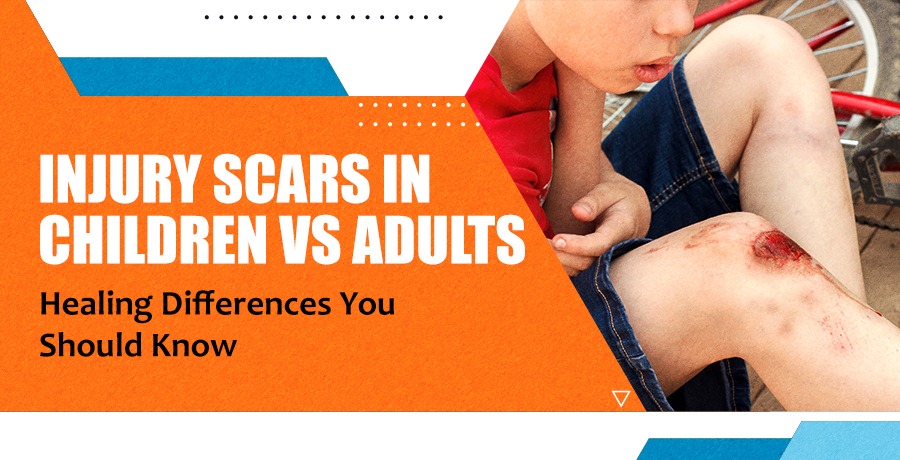
A child falls off their bike and scrapes their knee. An adult gets a deep cut while preparing a meal. Both injuries ultimately heal but their scars often tell very different stories. The scar in the child may be thick and raised for quite some time compared to the adult's fine, silvery line or sunken pucker. Have you ever wondered why that is?
The healing process is one of the amazing things our bodies do but it does not always work the same for everyone. Age is perhaps one of the most important factors that influence not only how quickly a wound heals, but what it looks like when it has healed. Understanding these things is the first step to providing the best care for you or your child and ensuring that a temporary injury doesn't turn into a permanent unwanted souvenir.
Let's take a closer look at the fascinating science behind why injury scars in children and adults can vary so much.
The Child's Healing Engine: Fast, Furious, and Overzealous
When it comes to healing, a child's body is a powerhouse. Their systems are primed for rapid growth and repair, and this biological urgency is on full display when their skin is injured.
1. Collagen Production on Overdrive:
Think of collagen as the body's natural scaffolding and spackle. When there is a wound, fibroblast cells arrive at the scene and immediately start to produce collagen to knit the skin back together. In children, fibroblasts are very active and in massive numbers. They work quickly, producing collagen at a furious pace. This causes the wound to close much faster than in an adult.
But that "fast and furious" approach to healing has a disadvantage. The system is so aggressive, it often fails to get the "stop" signal. An excess of collagen is laid down, meaning the scar formed is thick, raised and firm. This is considered a hypertrophic scar (elevated scars are sometimes called "keloids," when they extend beyond the original wounds' boundaries. Keloids and hypertrophic scars are more common in individuals with a genetic disposition; and children are that much more susceptible to either or both.
2. Rapid Cell Turnover:
The skin of a child is ever-renewing. With such high rates of cell turnover, skin cells develop quickly to cover the surface of the wound, which adds to the overall speed of healing.
3. A More Vigorous Inflammatory Response:
Inflammation is the first step in healing, it takes out debris and potentially ramps up infection. Children mount a really vigorous inflammatory response, with great effectiveness, this also invokes more scarring, and redness for a longer period of time.
The Adult's Healing Process: A Slow and Deliberate Approach
As we age, our bodies' processes become less frantic and chaotic. This applies directly to wound healing and scar formation with a whole new set of pros and cons.
1. A More Considered Collagen Response:
The fibroblasts of adult skin are less reactive and produce collagen slower and in a more considered fashion. This slower pace means the overall wound healing takes longer but reduces the risk of "overshoot." The body produces less scar tissue and often results in a flatter, thinner, less visible scar.
2. The "Baggage" of a Lifetime:
While the controlled response can be beneficial, adult skin has other factors working against it.
- Slower regeneration of cells: The time it takes to heal is prolonged, lengthening the window of time the wound is susceptible to re-infection or re-injury.
- Reduced elasticity of skin: Our skin loses the protein collagen and elastin as we age which is responsible for the firmness and bounce of all our tissues.This means, our skin is thinner and less resilient. A wound over skin that is not elastic will be able to pull apart more easily with movement that could result in a wider scar or a more atrophic scar (more indentured scar).
- Cumulative lifestyle factors: Years and years of sun exposure, smoking, sub-optimal diet or dehydration have all negatively influenced the skin and its health and ability to produce strong new tissue.
- Chronic health conditions: Adults are more likely to have chronic health conditions that are well known like diabetes and vascular disease. These problems affect blood flow and the delivery of oxygen and nutrients to the wound, severely compromise the healing process, and often lead to poor scar formation.
Practical Scar Care: Tailoring the Treatment to the Age
Because the healing mechanisms are so different, scar management strategies should be, too.
For Children (Managing the Overdrive):
The goal here is to gently control the body's overzealous healing response.
- Avoiding Sun Exposure Is Mandatory: A new, inflamed scar is very reactive to UV exposure. The sun will cause it to darken permanently (post-inflammatory hyperpigmentation), making it significantly more obscure. Keep your scar covered or use a high-SPF mineral sunscreen.
- Where is the silicone sheet or gel: Once the wound is closed, silicone therapy is a gold standard in preventing and treating raised scars. It hydrates the scar and exerts gentle pressure to cue the fibroblasts to slow the collagen output.
- Reduce Tension: Use appropriate bandages to support the body and skin while healing, as a stretched skin during healing can contribute to hypertrophic scarring.
For Adults (Supporting the Slower System):
The goal is to provide the body with the best possible resources to fuel its slower, more deliberate healing process.
- Focus on Nutrition and Hydration: Healing requires energy and building blocks. A diet rich in protein, vitamins (especially C and A), and minerals like zinc is crucial.Staying hydrated is equally important for healthy cell function.
- Keep the Wound Moist: Contrary to the old advice to "let it air out," wounds heal better in a moist, covered environment.This prevents thick scabs from forming and allows new skin cells to migrate across the wound more easily.
- Be Patient: Adult scars take a long time to fully mature and fade—often up to 18 months. Be consistent with your care routine and protect the scar from the sun throughout this period.
A Final Thought
The journey from injury to scar is a complex biological story. Children heal with remarkable speed and vigor, but this same power can lead to more conspicuous scarring. Adults heal with more precision, but their bodies face the cumulative challenges of time and lifestyle.
By understanding these fundamental differences, we can move beyond a one-size-fits-all approach and provide the specific care needed at every stage of life. Proper care from day one is the best way to ensure that a scar becomes nothing more than a faint, fading chapter in a much larger story.You can book an appointment with Dr. Anup Dhir for a personalized consultation on the best scar treatment plan for your specific needs.

